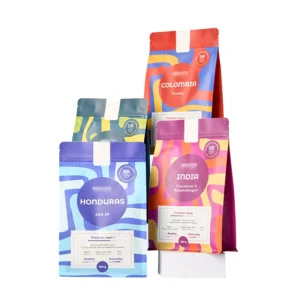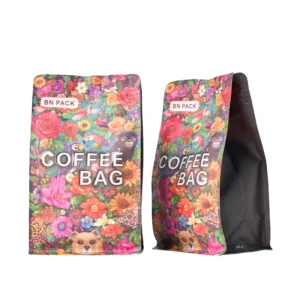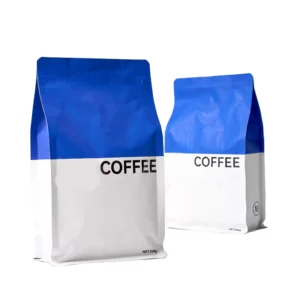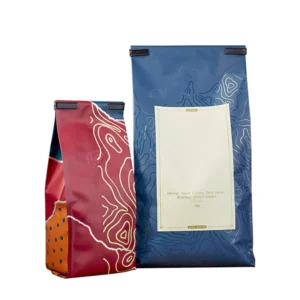Craving fresh, portable coffee? Ditch instant and learn how to make your own coffee bags! This guide demystifies the simple process, letting you enjoy your favorite blends anywhere. We’ll explore the easy steps to create single-serve bags, perfect for travel or a quick morning boost.
Beyond the DIY, we’ll delve into the commercial coffee bag manufacturing process. Discover how large-scale production ensures consistent quality and efficiency, from filling to sealing. Understand the techniques that bring your favorite bagged coffee to your cup.
What Are Coffee Bags
Recommended Coffee Bags
-
Black Kraft Paper Coffee Pouches
-
Biodegradable Stand Up Coffee Pouches With Zipper
-
Custom Drip Coffee Pouches
-
Custom Printed Flat Bottom Coffee Bag
-
Custom Recyclable Flat Bottom Coffee Bags
-
Eco Friendly Coffee Pouch
-
Flat Bottom Coffee Bag With Pocket Zipper
-
Foil Lined Side Gusset Coffee Packaging Bag
Coffee bags offer a convenient and straightforward way to enjoy freshly brewed coffee. Essentially, they are single-serve pouches filled with ground coffee, designed to be steeped in hot water, much like a tea bag. This eliminates the need for complex brewing equipment, making them ideal for those seeking a quick and easy coffee solution.
Unlike instant coffee, which is a dehydrated coffee extract, coffee bags contain actual ground coffee. This means they preserve the nuanced flavors and aromas of freshly roasted beans, providing a richer and more satisfying coffee experience. They bridge the gap between the convenience of instant coffee and the quality of traditional brewing methods.
How to Make Coffee Bags
The coffee bag manufacturing process begins with precise grinding and portioning of coffee. Then, filter material is formed and filled, followed by heat-sealing for freshness. For home-made versions, you can follow these steps:
Step 1: Gather Your Materials
Before you begin, ensure you have all the necessary materials. This includes high-quality coffee grounds, filter paper or tea bags (available in various sizes), a heat sealer or iron, a measuring spoon, and scissors. The quality of your coffee grounds will significantly impact the final product, so choose a blend you enjoy. Filter paper or tea bags should be food-grade and heat-sealable. Having all materials readily available will make the process smoother and more efficient, allowing you to focus on creating perfect coffee bags.
Choosing the right filter material is essential for optimal brewing. Ensure the filter paper or tea bags are designed for hot water and won’t impart any unwanted flavors. A heat sealer provides a clean and secure seal, preventing coffee grounds from escaping. If you don’t have a heat sealer, an iron can be used as an alternative, but be cautious to avoid burning the filter material. Consider the size of your chosen filter material and adjust the amount of coffee grounds accordingly to create the ideal single-serve portion.
Accurate measurements are crucial for consistent results. Use a measuring spoon to portion your coffee grounds, ensuring each bag contains the same amount. This will help maintain a consistent brew strength across all your coffee bags. Having sharp scissors will also be beneficial for trimming any excess filter material and creating neat, professional-looking bags.
Step 2: Measure and Fill the Coffee Bags
Begin by measuring the desired amount of coffee grounds for each bag. A standard serving is typically around 1-2 tablespoons, but you can adjust this based on your preference. Carefully fill each filter bag or tea bag with the measured coffee grounds. Ensure the grounds are evenly distributed within the bag to promote consistent extraction during brewing. Avoid overfilling the bags, as this can make sealing difficult and may result in grounds escaping during steeping.
When filling the bags, consider using a small funnel or a folded piece of paper to prevent spills and ensure accurate filling. This is particularly helpful when working with smaller filter bags or tea bags. Gently tap the filled bags to settle the grounds and create a more compact and even distribution. This will help prevent clumping and promote better water flow during brewing.
Once the bags are filled, carefully inspect them to ensure there are no loose grounds clinging to the outside of the filter material. This will prevent any unwanted sediment in your brewed coffee. If you notice any loose grounds, gently brush them away before proceeding to the sealing step.
Step 3: Seal the Coffee Bags
To seal the bags, use a heat sealer or an iron. If using a heat sealer, follow the manufacturer’s instructions to create a secure and airtight seal. If using an iron, place the open end of the bag between two pieces of parchment paper and gently press with the iron for a few seconds. Ensure the seal is strong enough to prevent the bag from opening during brewing. A secure seal is crucial for maintaining the freshness of the coffee grounds and preventing any leakage.
Heat Sealer:
- Ensure the heat sealer is preheated to the appropriate temperature.
- Place the open end of the filled bag between the sealing jaws.
- Apply pressure and hold for the recommended time to create a secure seal.
Iron:
- Place the open end of the filled bag between two sheets of parchment paper.
- Set the iron to a medium heat setting.
- Gently press the iron onto the parchment paper for a few seconds, applying even pressure.
After sealing, carefully inspect each bag to ensure the seal is complete and there are no gaps or weak points. If you notice any weak seals, reseal the bag to prevent leakage. Trim any excess filter material around the seal to create a neat and professional finish. This will also help prevent the bag from unraveling during brewing.
How to Make Cold Brew Coffee Bags

The commercial cold brew coffee bag manufacturing process involves grinding coffee coarsely, filling specialized cold-brew filter bags, and often nitrogen-flushing for extended freshness. For home preparation, here’s how to create your own cold brew coffee bags:
Step 1: Gather Your Materials
For cold brew, you’ll need coarsely ground coffee, larger cold brew filter bags (or food-grade muslin cloth), a measuring scoop, and a container for steeping. Coarsely ground coffee is essential for cold brew, as it prevents over-extraction and bitterness. Cold brew filter bags or muslin cloth should be durable and designed for extended immersion in water. The container should be large enough to hold the bags and the required amount of water. Having all materials prepared will streamline the process and ensure a successful cold brew.
The type of filter material you choose is crucial for cold brew. Opt for bags or cloth with a fine weave to prevent sediment from escaping, but not so fine that it hinders water flow. A large container, such as a pitcher or jar, is necessary for the steeping process. Ensure it’s clean and made of a non-reactive material like glass or food-grade plastic. The measuring scoop will help you accurately portion the coffee for each bag, ensuring consistent brew strength.
Consider the ratio of coffee to water for your cold brew. A general guideline is 1:4 to 1:8, depending on your desired strength. Adjust the amount of coffee grounds accordingly, and select a filter bag size that can accommodate the chosen portion. Having all the correct tools will ensure you can craft a delicious, smooth cold brew.
Step 2: Measure and Fill the Bags
Measure the desired amount of coarsely ground coffee for each bag. Cold brew typically requires a higher coffee-to-water ratio than hot brew, so use a generous amount. Carefully fill each cold brew filter bag or muslin cloth with the measured coffee grounds. Ensure the grounds are evenly distributed to promote consistent extraction during the long steeping process. Avoid overfilling the bags, as this can hinder water circulation and extraction.
When filling the bags, use a wide-mouthed funnel or a large spoon to prevent spills and ensure accurate filling. This is particularly important when working with larger bags or cloth. Gently shake the filled bags to settle the grounds and create a more even distribution. This will help prevent clumping and promote better water flow during the steeping process.
Once the bags are filled, carefully inspect them to ensure there are no loose grounds clinging to the outside of the filter material. This will prevent any unwanted sediment in your cold brew. If you notice any loose grounds, gently brush them away before proceeding to the sealing or tying step. If using muslin cloth, tie the cloth securely to form a pouch.
Step 3: Seal or Tie the Bags (and Steep)
If using cold brew filter bags, many come with drawstrings or can be folded and clipped. If using muslin cloth, tie the open end securely to create a sealed pouch. Place the filled bags into your chosen container and add cold, filtered water. Ensure the bags are fully submerged. Steep the bags in the refrigerator for 12-24 hours, depending on your desired strength. A secure closure is crucial for preventing grounds from escaping during the extended steeping period.
- Filter Bags:
- Ensure the bag is closed securely using the provided drawstring or clip.
- Double-check that there are no gaps or openings.
- Muslin Cloth:
- Tie the open end of the cloth tightly to form a secure pouch.
- Ensure the knot is strong enough to prevent the pouch from opening.
After steeping, carefully remove the bags from the water, allowing any excess liquid to drain back into the container. Discard the used coffee grounds. Your cold brew concentrate is now ready to be diluted with water or milk and enjoyed. Store the concentrate in the refrigerator for up to a week.
Conclusion
Creating your own coffee bags offers a personalized and convenient way to enjoy fresh coffee. Mastering the process, from choosing the right filter to sealing techniques, ensures a perfect brew every time. This DIY approach not only elevates your coffee experience but also provides a sustainable alternative.
For those seeking high-quality, wholesale coffee bags, BN Pack offers a comprehensive range of options. Their expertise in coffee bag manufacturing ensures durable and customizable solutions. Explore their selection to find the perfect packaging for your coffee needs.
Ready to streamline your coffee packaging? Contact BN Pack today to discover their wholesale coffee bag options and elevate your brand with premium, custom solutions.








